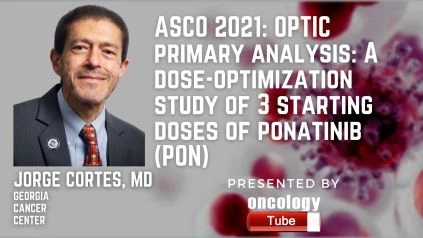Jorge Cortes, MD, Director of the Georgia Cancer Center discusses the ASCO 2021 Abstract – OPTIC primary analysis: A dose-optimization study of 3 starting doses of ponatinib (PON).
Link To Abstract –
https://meetinglibrary.asco.org/record/195828/abstract
Background information:
PON, a third-generation tyrosine kinase inhibitor (TKI), showed deep and long-lasting responses and survival in patients with chronic-phase chronic myeloid leukemia (CP-CML) who were resistant or intolerant to second-generation TKI therapy (PACE; NCT01207440); post-hoc analysis suggested a link between dose and both adverse events and response. The primary analysis of OPTIC (NCT02467270), a randomized, phase 2 study using a new response-based PON dosage regimen in patients with resistant/intolerant CP-CML, is presented here.
Methodologies:
Pts with CP-CML resistant to two TKIs or the BCR-ABL1 T315I mutation were given PON beginning doses of 45 mg (cohort A; 45 mg 15 mg), 30 mg (B; 30 mg 15 mg), or 15 mg (C) once daily. In cohorts A and B, doses were lowered to 15 mg after achieving a 1% BCR-ABL1IS. The primary aim is a 1% BCR-ABL1IS reduction after 12 months; supplementary objectives include cytogenetic and molecular responses, as well as safety outcomes. An independent review group adjudicated AOEs prospectively.
The following are the outcomes:
283 participants were randomly assigned to one of three groups (A/B/C: n=94/95/94) and had the following baseline characteristics: 99 percent had resistant illness; 40% had one baseline mutation; median age 48 years (1881 years); 98 percent got two (55 percent) TKIs; 99 percent had resistant illness; 40 percent had one baseline mutation (23 percent T315I). 134 patients (47 percent; n=50/41/43) remained on therapy at the primary analysis, with a median follow-up of 32 months, while 204 patients (72 percent) had PON exposure of fewer than 12 months. At 12 months, 44 percent (41/93) in cohort A, 29 percent (27/93) in cohort B, and 23 percent (21/91) in cohort C had attained 1% BCR-ABL1IS (Table); cohort A met the main goal. After attaining response (A/B), dose reductions to 15 mg were 48/29 percent. Thrombocytopenia, neutropenia and anemia were the most prevalent grades 3 TEAEs, accounting for 27%, 17%, and 7%, respectively. Cohorts A (10 percent /4 percent), B (5 percent /4 percent), and C (3 percent /3 percent) reported AOEs/serious AOEs. For TEAEs (A/B/C), dose reductions or discontinuations were 46/35/32 percent and 19/16/14 percent, respectively.
Final Thoughts:
The optimal benefit: a risk profile for PON was achieved with a response-based dosing regimen starting at 45 mg/d and decreasing to 15 mg/d after achieving 1% BCR-ABL1IS, according to the OPTIC primary analysis; 30 mg15 mg and 15 mg cohorts may provide benefit, especially in patients without the T315I mutation (Table). The substantial survival results in patients with CP-CML resistant to second-generation BCR-ABL1 TKI treatment, both with and without BCR-ABL1 mutations, corroborate the documented 1% BCR-ABL1IS responses. NCT02467270 is the number for the clinical study.

